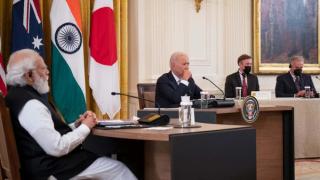The United States is still the “indispensable nation” in maintaining a favorable balance of power against Russia in Europe and China in Asia. But the relative decline in America’s military advantage over these rivals will demand reimagining the ways in which it meets these challenges – particularly if, in the words of U.S. Indo-Pacific Coordinator Kurt Campbell, the United States is to successfully sustain “deep commitments” in both regions.
This is not necessarily a matter of mustering will, but of reimagining ways – including how the United States goes about empowering its allies and partners to manage affairs in their own regions.
Encouragingly, efforts to “reinvigorate and modernize” U.S. alliances and partnerships have been a central component of Biden’s foreign policy agenda. A year ago, Secretary of State Antony Blinken and Secretary of Defense Lloyd Austin labelled U.S. allies “force multipliers.” In outlining the administration’s concept of “integrated deterrence,” Austin further stated that emerging threats would require the United States “to coordinate better, to network tighter, and to innovate faster” with its allies and partners. And as Mira Rapp-Hooper, the lead author of the Biden administration’s Indo-Pacific Strategy, recently acknowledged, “allies and partners are not a luxury, they are a strategic necessity.”
Challenges in Europe notwithstanding, the Biden administration’s avowed priority theatre for realising this vision remains the Indo-Pacific. And for all the criticisms of Biden’s wider regional strategy, on this score at least he deserves credit. As we argue in our contribution to the United States Studies Centre’s flagship report “State of the United States: Biden’s Agenda in the Balance,” there is an emerging step-change in Washington’s approach to empowering its allies and partners.
This goes beyond the alliance restoration efforts that largely occupied Biden’s first year in office as he sought to repair the damage wrought by his predecessor, Donald Trump. As part of what National Security Advisor Jake Sullivan has called a “latticework” of overlapping cooperative partnerships, the Biden administration has sought to empower key allies and partners to better meet their own unique security challenges and to contribute to collective balancing efforts in the Indo-Pacific. This has involved both what we term “stepping in” to new and pre-existing mechanisms designed for empowerment and “stepping out” of the way of allies’ self-strengthening efforts.
“Stepping in” to work together
The United States appears to have become more willing to step in to help allies and partners access advanced defense technologies and platforms and to streamline cooperation on future capabilities. The announcement of the AUKUS partnership in September 2021 was the signature effort in this regard. The decision to provide Australia with privileged access to U.S. nuclear-propulsion technology may have dominated headlines. But the broader thrust of AUKUS targets expanded trilateral cooperation with the United Kingdom on a wider range of defense science and technology, industrial, and capability projects. In that sense, AUKUS dovetails with efforts to expand cooperation through the U.S. National Technology and Industrial Base (NTIB) – a mechanism that has historically failed to deliver on its promise of greater integration and access for top-tier U.S. allies.
Japan has also benefitted from the Biden team’s willingness to lean into cooperation. In January, defense and foreign ministers from both countries announced a framework for advancing collaboration of defense technology development, with an initial focus on counter-hypersonic capabilities. A straight line can be drawn between this announcement and a request made to the Pentagon by Japan’s Ministry of Defense last October for more defense co-development projects. For Tokyo, this is particularly welcome given its bad experiences with the U.S. Foreign Military Sales program and its efforts to reinvigorate its own domestic industrial and technological capacity.
“Stepping out” of the way of self-strengthening
The United States has also become more willing to step out of the way of regional allies and partners’ efforts to acquire the means to defend themselves. This has involved removing often outdated regulations originally designed to limit junior alliance partners’ options, as well as trying to be more flexible in accommodating the choices of emerging partners.
For example, in May 2021 Biden and South Korean President Moon Jae-in agreed to remove the last vestiges of the 1979 U.S.-Korea Ballistic Missile Guidelines. Originally established to constrain South Korea’s then-authoritarian military regime, the guidelines made less sense today in the face of North Korea’s nuclear and missile threats. Their removal effectively opens the path for Seoul to develop and field more advanced land and maritime strike capabilities, and lowers barriers to realizing its space ambitions. These advancements will enable a more self-reliant and powerful South Korea to meet its own security needs but will also make it a more capable partner for the United States and other regional partners.
Help me, help you
Good progress notwithstanding, questions remain as to how far the United States is willing to take this emerging empowerment agenda.
First, how far is the United States willing to step in to help? Enduring U.S. domestic political factors and outdated export controls threaten to impede deeper industrial and technological integration with close allies. Such impediments are not unique to the Biden administration, though its “Buy American” agenda will make these barriers even more politically difficult to lower than they already were.
Encouragingly, Indo-Pacific allies are coordinating pushback against new provisions that threaten to limit allied input into U.S. defense supply chains and are agitating for greater input through mechanisms like the NTIB. But without sustained political buy-in to a reform agenda inside the Beltway, these restrictions will almost certainly limit the possibilities for new alliance initiatives on defense technology.
Second, to what extent is the United States willing to give way to self-strengthening? Questions remain over the extent to which Washington is willing to facilitate empowerment when its strategic preferences diverge with those of allies or partners. For example, India continues to face the threat of U.S. sanctions for its 2018 purchase of Russian S-400 missile defense systems under the Countering America’s Adversaries Through Sanctions Act (CAATSA). This threat lingers even though the United States cannot offer a suitable alternative that adequately – and affordably – meets India’s defense needs.
This situation is only made more difficult by the Ukraine conflict. Some officials have hinted that a one-time CAATSA waiver for the S-400 is possible, but congressional support for a blanket waiver may be faltering due to India’s unwillingness to take a harder stance against Russia’s actions in Europe. What Biden decides will be a litmus test of Washington’s ability to reconcile the empowerment of Indo-Pacific partners with its other geostrategic priorities.
It’s still unclear whether the Biden administration can follow through on this allied empowerment agenda, or whether it will ultimately give in to its superpower instinct of preferring less capable but more dependent allies. What cannot be disputed is the necessity of these efforts. The era of collective defense has already arrived, and U.S. allies and partners will need to play a bigger role if it is to be a success.
And in that sense, whether by stepping in or stepping out, Washington will need to ensure that its fancy footwork ultimately helps allies and partners to step up.







